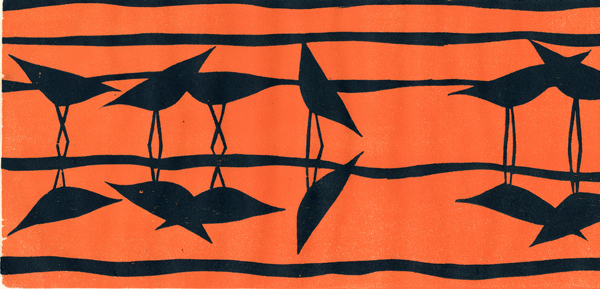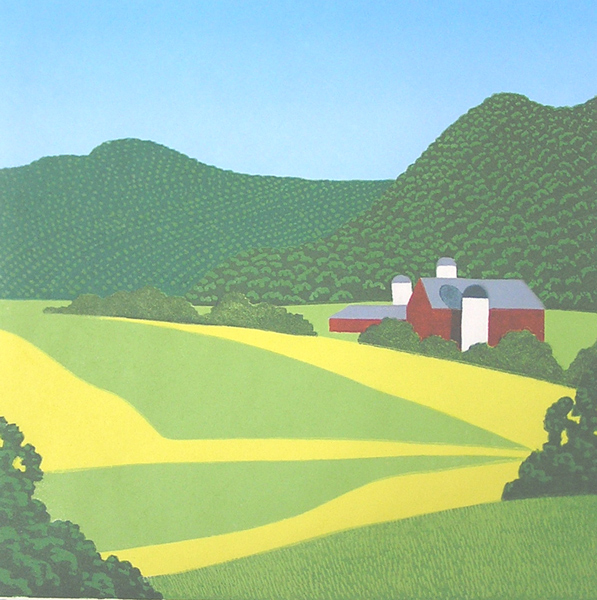
Friday, July 6, 5-8PM
Frog Hollow and Event Sponsor VTel present an overview of of Vermont printmaker Sabra Fields work for the past fifty years. Perhaps no artist is more identified with having captured Vermont’s pastoral qualities than Sabra Field. Since 1973 Sabra Field has been a featured artist at the Vermont State Craft Center, Frog Hollow. This exhibit spans her career with a special emphasis on her evolution of process and how it specifically pertains to her Vermont Landscapes. A unique aspect of this retrospective is that almost all of the hand-pulled woodblock prints on display will be available for purchase. The exhibit provides a rare glimpse at Sabra’s early work and a preview of things to come.

About Sabra Field:
The iconic Vermont artist Sabra Field has spent the last 43 years living on and working with the Vermont landscape. She made Vermont her home, and in turn the landscape took her in and changed the way she viewed the world around her. Field was born in Tulsa, Oklahoma, raised in Connecticut and New York, yet still feels that Vermont is her home. She is the descendant of a Southern Vermont printer and post-master general, Anthony Haswell, tying her to this state at her very roots.
Field’s dedication to the arts began at the young age of 8 years old, when she stated that her future occupation would be an “artist.” For her undergraduate college education she attended Middlebury College. While there was no Studio Art major there at that time, her years spent in Middlebury served to hone her interest in and commitment to Vermont, New England and the arts. Field went on to Wesleyan University for Graduate studies in the arts. This is where she learned printmaking under the master printmaker Russell T. Limbach. Although her first job upon graduating from Wesleyan was teaching High School art, she had a deep fear of becoming only a teacher. Her work at this time was very different then it is now – her prints were monochromatic, political, and included words or other such elements that are not found in her later work.
In the late 1960’s, Field was part of a movement of people yearning for country life, which subsequently transformed the Vermont landscape. She left Connecticut and moved to East Barnard. In Vermont she found “open spaces, beauty, an ethic of self-reliance and relatively cheap land prices” that suited her needs. The move to the Vermont countryside dramatically changed Field’s work. Vermont inspired her; specifically, the landscape proved to her that she belonged here. Her work became more colorful, and focused more on her surroundings. She took up all manner of Vermont activities, including “backyard farming.” Vermont embraced her as much as she embraced it. The market for her prints grew after she arrived. 5 years of living in Vermont led to her marriage to Spencer Field and the opening of Tontine Press.
Without this move, Field may not have become the artist that she is today. In 1975, Field won the Statewide Bicentennial Poster Competition and was featured in Vermont Life. 1976 brought her the large-bed Charles Brand press which allowed her to print with multiple colors on large blocks. With this she created Valley of the White River, arguably one of the prints to make her famous. She sold thousands – people saw it and immediately were reminded of Vermont. By the mid 1980s, she was the most well-known and popular visual artist in the state. The accomplishments that followed prove this.
William Gray, the 1991 Chairmen of the Vermont Bicentennial Commission said of her work “In many ways, the work of Sabra Field has affected the vision of us all” a point that many agree with. In 1984 Middlebury College gave her the Alumni Achievement Award and an Honorary Doctor of Arts in 1991. That same year she was named an Extraordinary Vermonter by Governor Kunin and created the State Bicentennial Stamp from the print Windrows. Not only was this stamp popular among the 500,000 people of Vermont, but over 60 million sold nationally. In 1999, Governor Dean gave her the Governor’s Award for Excellence in the Arts. Middlebury College created a collection of her prints titled The Sabra Field Collection, to be used for study and loans for special exhibitions.
Sabra Field’s work can be seen every where, from corporate offices and government buildings to private homes and small general stores. Her depictions of Vermont are displayed proudly in galleries, hospitals, schools, day cares and even boathouses and deer camps. Not only does Sabra Field’s work depict a recognizable version of Vermont, but her passion for the preservation of the landscape is as appealing to Vermonters as her work is.
